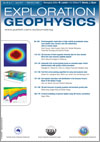
Exploration Geophysics
Volume 48 Number 2 2017
EG15121Electromagnetic exploration in high-salinity groundwater zones: case studies from volcanic and soft sedimentary sites in coastal Japan
In order to evaluate the freshwater–saltwater interface of three sample areas in the Chugoku-Shikoku region of western Japan, we conducted CSAMT surveys at locations with varying hydrogeological features, and performed laboratory tests to measure the electrical properties of rock core samples from each site.
EG150703D inversion of total magnetic intensity data for time-domain EM at the Lalor massive sulphide deposit
3D voxel inversion of HeliSAM data at the Lalor massive sulphide deposit suffers from: (1) contamination of early-time data by the near-surface infrastructure and (2) creation of a mathematically acceptable but non-geologic model from inversion of late-time data. We propose a procedure that incorporates the infrastructure in our inversion, and a warm-start approach to overcome the non-uniqueness.
EG14120Automatic first-arrival picking based on extended super-virtual interferometry with quality control procedure
We have developed an automatic first-arrival picking method that combines extended super-virtual interferometry with quality control. The field data examples show that the proposed method yields stacked sections of similar quality to those obtained by laborious and costly manual picking.
EG15120Fast first arrival picking algorithm for noisy microseismic data
We have developed a new fast picking method, optimised for noisy microseismic data, using cross-correlation and stacking. In experiments with synthetic data and field data, this method produces reliable results and the computation time is dramatically reduced.
EG15127Gas hydrate saturation and distribution in the Kumano Forearc Basin of the Nankai Trough
The spatial distribution and characteristics of gas hydrates in the Kumano Forearc Basin of the Nankai Trough were investigated by using logging data and 3D seismic data. This study demonstrates that tectonic activity of the underlying accretionary prism at the plate convergent margin is responsible for hydrate formation.
EG150233D joint inversion of gravity-gradient and borehole gravity data
We perform 3D joint inversion of surface and borehole data using cokriging. The examples presented demonstrate that the method is remarkable in its ability to include the geological information and physical property. Also, both depth and horizontal resolution of the recovered model can be improved by joint inversion.
3D Fourier convolution is a fast method for forward modelling irregular magnetic bodies. A kernel consisting of the field of a single dipole, convolved over a random distribution of dipoles, simulates the heterogeneity of bulk material. A demonstration studies the depth information collected by different survey parameters.

